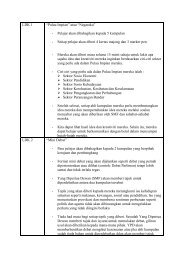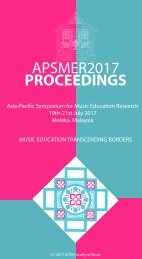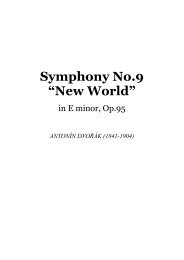APSMER2017 PROCEEDINGS
Create successful ePaper yourself
Turn your PDF publications into a flip-book with our unique Google optimized e-Paper software.
Proceedings of the 11th Asia-Pacific Symposium for Music Education Research<br />
(APSMER 2017) 19th to 21st July 2017, Melaka MALAYSIA<br />
Importance of the Research<br />
Including the Zapin genre as educational music material may be beneficial<br />
for students to deepen their understanding of the different musical traditions<br />
of Malaysia, while developing knowledge about the social, cultural and<br />
historical contexts of this music. Additionally, students may develop skills in<br />
interpretation through a better understanding of the stylistic elements and<br />
form of Zapin music.<br />
Conclusion<br />
The creation of a published collection of Malay Asli music arrangements is<br />
likely to increase international awareness and appreciation of the traditional<br />
music of Malaysia. This article has focused on the first of this collection of<br />
scores which will provide musicians across the globe with the opportunity to<br />
learn how to play traditional Malay Asli music in a Western classical<br />
ensemble.<br />
It is hoped that students who play Western classical instruments will<br />
be able to benefit from using this new score for flute, viola and piano,<br />
towards an increased awareness and understanding of the Zapin style. By<br />
playing through this score, students can come to a better understanding about<br />
the correct execution of ornaments, as well as traditional Malay ensemble<br />
performance in general.<br />
Acknowledgements<br />
This project is funded by an FRGS research grant entitled “Sourcing and<br />
Preserving Malay Asli Music Through the Development of a Book of Music<br />
Score of Arrangements for Small Ensembles, with an Accompanying CD”.<br />
The authors wish to thank Universiti Pendidikan Sultan Idris and the<br />
Malaysian Government for their support of this research.<br />
References<br />
Chye, G. N. K. (2016). Violin in ensemble for dance: Improvisatory styles in<br />
the ‘adopted’ Malay dances of Zapin. In G. Jähnichen (Ed.), Studia<br />
Instrumentorum Musicae Popularis IV (New Series) (pp. 217-224).<br />
Münster: MV-Wissenschaft.<br />
Ho, S. (2015). Dondang sayang. Retrieved from the Singapore Infopedia<br />
website:<br />
http://eresources.nlb.gov.sg/infopedia/articles/SIP_495_2004-12-<br />
20.html<br />
Matusky, P. & Tan, S. B. (2004). The music of Malaysia: The classical, folk<br />
and syncretic traditions. Hampshire: Ashgate.<br />
Mohamed Ghouse Nasuruddin. (2007). Traditional Malaysian music.<br />
Selangor Darul Ehsan: Malaysia.<br />
Mohd Anis Md Nor. (2001). Blurring Images, glowing likenesses: Old and<br />
new styles in traditional dances of Malaysia. Yearbook for<br />
Traditional Music, 33, 65-71. doi:doi:10.2307/1519631<br />
Mohd Anis Md Nor. (2009). The spiritual essence of Tawhid (Oneness-<br />
Peerlessness) in zapin dance performance by the beholders of the<br />
33








